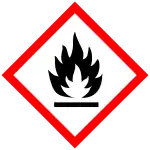Cyclopropanol
Cyclopropanol ist eine organische chemische Verbindung aus der Gruppe der Cycloalkanole. Sie enthält eine Cyclopropylgruppe mit einer Hydroxygruppe. Die Verbindung ist aufgrund des dreigliedrigen Rings sehr instabil und geht rasch Ringöffnungsreaktionen ein. Cyclopropanol ist anfällig für eine Umlagerung (Isomerisierung) zu Propanal:[2][3]

Umlagerung von Cyclopropanol
| Strukturformel | ||||||||||||||||
|---|---|---|---|---|---|---|---|---|---|---|---|---|---|---|---|---|
 | ||||||||||||||||
| Allgemeines | ||||||||||||||||
| Name | Cyclopropanol | |||||||||||||||
| Summenformel | C3H6O | |||||||||||||||
| Externe Identifikatoren/Datenbanken | ||||||||||||||||
| ||||||||||||||||
| Eigenschaften | ||||||||||||||||
| Molare Masse | 58,08 g·mol−1 | |||||||||||||||
| Aggregatzustand |
flüssig[1] | |||||||||||||||
| Sicherheitshinweise | ||||||||||||||||
| ||||||||||||||||
| Soweit möglich und gebräuchlich, werden SI-Einheiten verwendet. Wenn nicht anders vermerkt, gelten die angegebenen Daten bei Standardbedingungen. | ||||||||||||||||
Gewinnung und Darstellung
Cyclopropanol kann durch Reaktion von Ethylmagnesiumbromid mit Epichlorhydrin gewonnen werden.[4] Derivate der Verbindung können durch die Kulinkovich-Reaktion dargestellt werden.[5] Auch eine Biosynthese aus Cyclopropan[6] und weitere Synthesewege[7] sind bekannt.
Einzelnachweise
- Fluorochem: Safety Data Sheet, abgerufen am 27. Dezember 2019.
- J. K. Magrane, D. L. Cottle: The Reaction of Epichlorohydrin with the Grignard Reagent. In: Journal of the American Chemical Society. 64, 1942, S. 484, doi:10.1021/ja01255a004.
- Glenn W. Stahl, D. L. Cottle: The Reaction of Epichlorohydrin with the Grignard Reagent. Some Derivatives of Cyclopropanol. In: Journal of the American Chemical Society. 65, 1943, S. 1782, doi:10.1021/ja01249a507.
- John D. Roberts, Vaughan C. Chambers: Small-Ring Compounds. VI. Cyclopropanol, Cyclopropyl Bromide and Cyclopropylamine. In: Journal of the American Chemical Society. 73, 1951, S. 3176, doi:10.1021/ja01151a053.
- John J. Eisch, Adetenu A. Adeosun, John N. Gitua: Mechanism of the Kulinkovich Cyclopropanol Synthesis: Transfer-Epititanation of the Alkene in Generating the Key Titanacyclopropane Intermediate. In: European Journal of Organic Chemistry. 2003, 2003, S. 4721, doi:10.1002/ejoc.200300588.
- J. Salaün, M.S. Baird: Biologicaliy Active Cyclopropanes and Cyclopropenes. In: Current Medicinal Chemistry. Vol. 2, Nr. 1, 1995, S. 511–542, hier S. 512 (eingeschränkte Vorschau in der Google-Buchsuche).
- F. J. McQuillin, M. S. Baird: Alicyclic Chemistry:. CUP Archive, 1983, ISBN 978-0-521-28391-5, S. 102 (eingeschränkte Vorschau in der Google-Buchsuche).
This article is issued from Wikipedia. The text is licensed under Creative Commons - Attribution - Sharealike. The authors of the article are listed here. Additional terms may apply for the media files, click on images to show image meta data.

